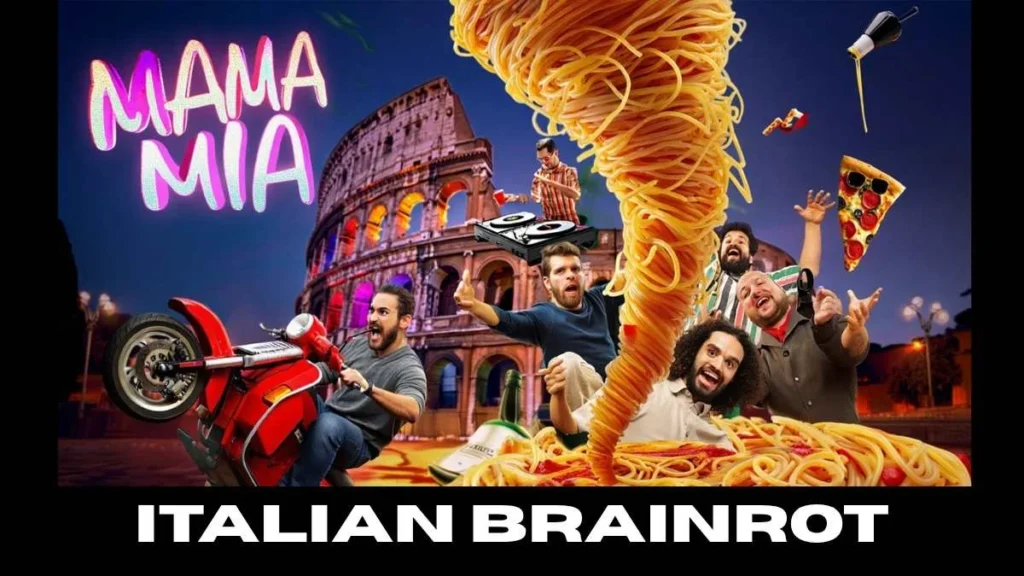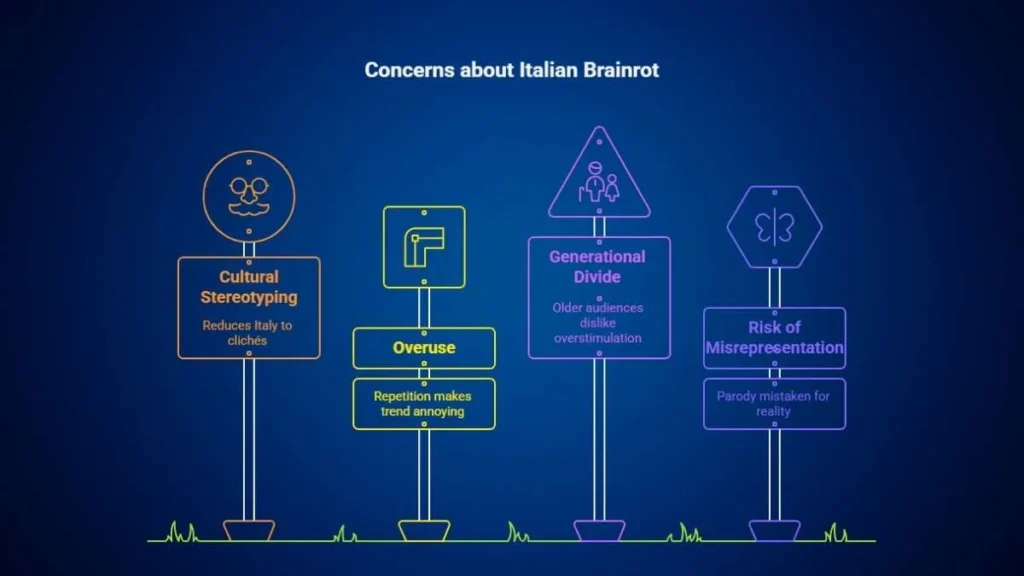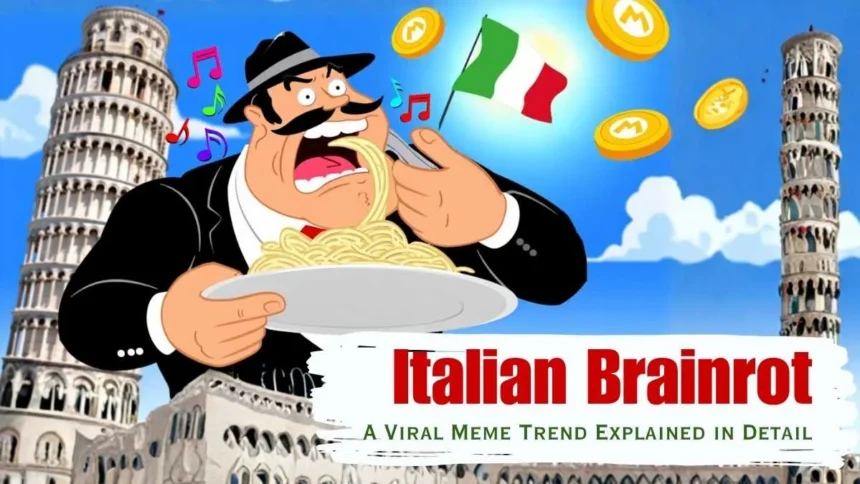Italian Brainrot is a viral internet phenomenon that combines Italy-inspired memes, exaggerated humor, and chaotic editing into an addictive form of entertainment. It belongs to the larger “brainrot” trend, where overstimulating, repetitive content dominates users’ feeds until it becomes a cultural obsession.
So, what is Italian Brainrot exactly? At its simplest, it is short-form content that caricatures Italian culture, pizza, pasta, hand gestures, dramatic accents, blended with fast cuts, remixes, and absurd humor. Instead of presenting authentic traditions, this trend exaggerates stereotypes for comedic effect. The result is both lighthearted parody and meme-heavy chaos that people binge endlessly across TikTok, Instagram, and YouTube.
Defining the Phenomenon
Italian Brainrot is a subgenre of digital meme culture that thrives on exaggerating familiar symbols of Italy, blending food icons like pizza, pasta, spaghetti, and gelato with the comedic flair of dramatic hand gestures, sped-up remixes of classics such as That’s Amore or Mambo Italiano, and a backdrop of clichés from mafia jokes to Vespa rides, Colosseum imagery, and Vatican memes. Loud captions, chaotic editing, and over-the-top expressions tie everything together, turning Italy into a playful caricature that resonates widely because it transforms instantly recognizable elements into shareable, fast-paced comedy.

Origins of the Trend
The Italian meme wave emerged around TikTok in 2023–2024, piggybacking on existing brainrot content such as Skibidi Toilet and Fanum Tax. Unlike those, however, this trend leaned on widely recognized cultural cues.
- Pizza and pasta jokes were already popular.
- Classic Italian music offered a ready-made soundtrack.
- Gestures and accents were easily parodied.
With such universal symbols, creators quickly produced content that could be understood worldwide, fueling the viral spread.
Why It Went Viral
Several factors explain its explosive growth:
1. Relatability Through Food
Pizza and pasta are universally loved. Memes centered around them automatically resonate with broad audiences.
2. Visual Humor
Italian hand gestures are dramatic and instantly recognizable. They translate well into meme format, especially in fast-cut editing styles.
3. Cultural Parody
Unlike niche memes, Italian Brainrot relies on stereotypes most people already know. This familiarity fuels quick laughs without requiring background context.
4. Short-Form Addictiveness
The “brainrot” label reflects how people binge these videos. The chaotic mix of music, captions, and humor is designed to hook viewers instantly.
Key Features of Italian Brainrot Content
Typical traits include:
- Use of the Italian flag in backgrounds or emojis.
- Remixes of Dean Martin or operatic classics at high speed.
- Random additions like Super Mario sound effects.
- Bold captions such as: “POV: You ate ONE spaghetti and now…”
- Chaotic visual edits, jump cuts, motion blur, zoom-ins.
All of these combine to make videos instantly recognizable as part of the “brainrot” family.
Cultural Influence
Italian Brainrot has reshaped how Italian culture appears in online spaces, not through accuracy but through parody, making pizza, pasta, hand gestures, and operatic music symbols of chaotic humor. It has boosted Italy’s visibility in pop culture, turning familiar clichés into a global inside joke that audiences from New York to Tokyo can understand instantly. For many, engaging with Italian Brainrot signals participation in the latest wave of meme identity, while for creators, it has become a flexible template to remix with other trends like sigma edits, rizz humor, or anime parodies. Ultimately, the trend has cemented itself as a shared cultural reference point that connects global audiences through humor, exaggeration, and overstimulating content.
Elements and Audience Reaction
| Element Used | Example in Memes | Audience Response |
| Food | Spaghetti flying across the screen | Relatable + funny |
| Hand Gestures | Pinched fingers looped on repeat | Instantly recognizable |
| Music | That’s Amore sped up | Nostalgic + chaotic |
| Mafia Jokes | Suit-clad characters eating pizza | Satirical humor |
| Random Inserts | Mario coins sound | Absurd laughter |
Criticism and Concerns
Despite its playful nature, not everyone sees this trend positively.
- Cultural Stereotyping: Some argue it reduces Italy to clichés.
- Overuse: Repetition makes it annoying after a point.
- Generational Divide: Older audiences often dislike overstimulating edits.
- Risk of Misrepresentation: Viewers unfamiliar with Italy may conflate parody with reality.
Yet, many Italians and non-Italians see it as affectionate humor rather than harmful mockery.

Comparing It With Other Meme Waves
- Skibidi Brainrot relies on bizarre toilet-headed characters, while Italian Brainrot uses real cultural cues.
- Ohio memes portray absurdity tied to a U.S. location, whereas Italian Brainrot is global.
- Fanum Tax is tied to a specific streamer, making it less universal.
The difference lies in familiarity; Italy is instantly understood, giving this meme broader appeal.
FAQs
Q1: Is Italian Brainrot offensive to Italians?
Most take it as a parody, though some find it overly stereotypical.
Q2: Does Italian Brainrot only exist on TikTok?
No, it spreads across Instagram, YouTube Shorts, Reddit, and even X (Twitter).
Q3: Can brands use Italian Brainrot in marketing?
Yes, food and travel brands already experiment with playful spin-offs.
Conclusion
Italian Brainrot shows how digital culture thrives on exaggeration and parody. By remixing hand gestures, food, and music into chaotic short videos, it creates a universal inside joke that people can laugh at, regardless of their background.
While it risks oversimplifying Italian culture, its addictive energy demonstrates how memes transform national icons into viral internet symbols. Whether it vanishes tomorrow or leaves lasting traces, it has already proven the internet’s love for humor that is chaotic, loud, and unmistakably memorable.







